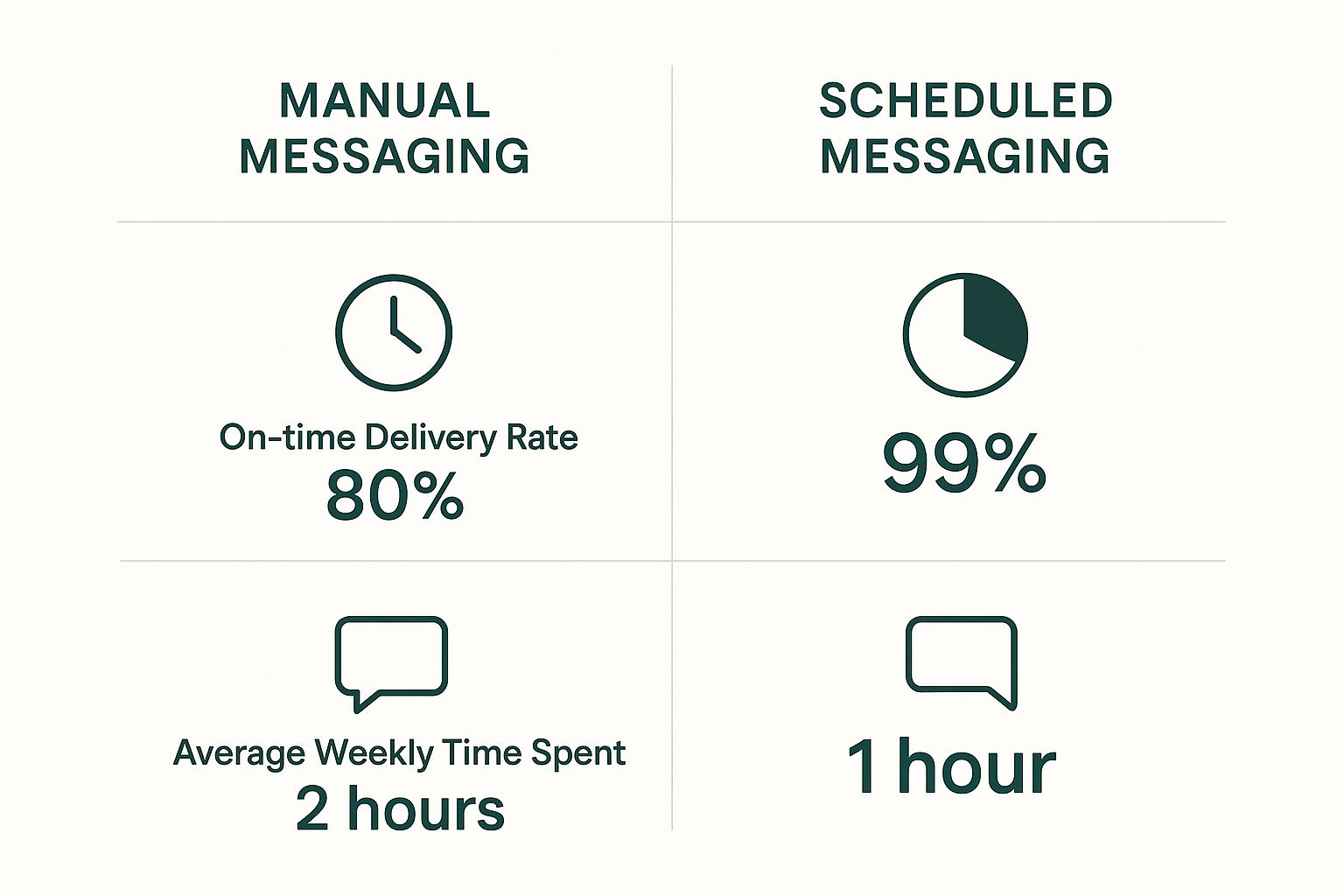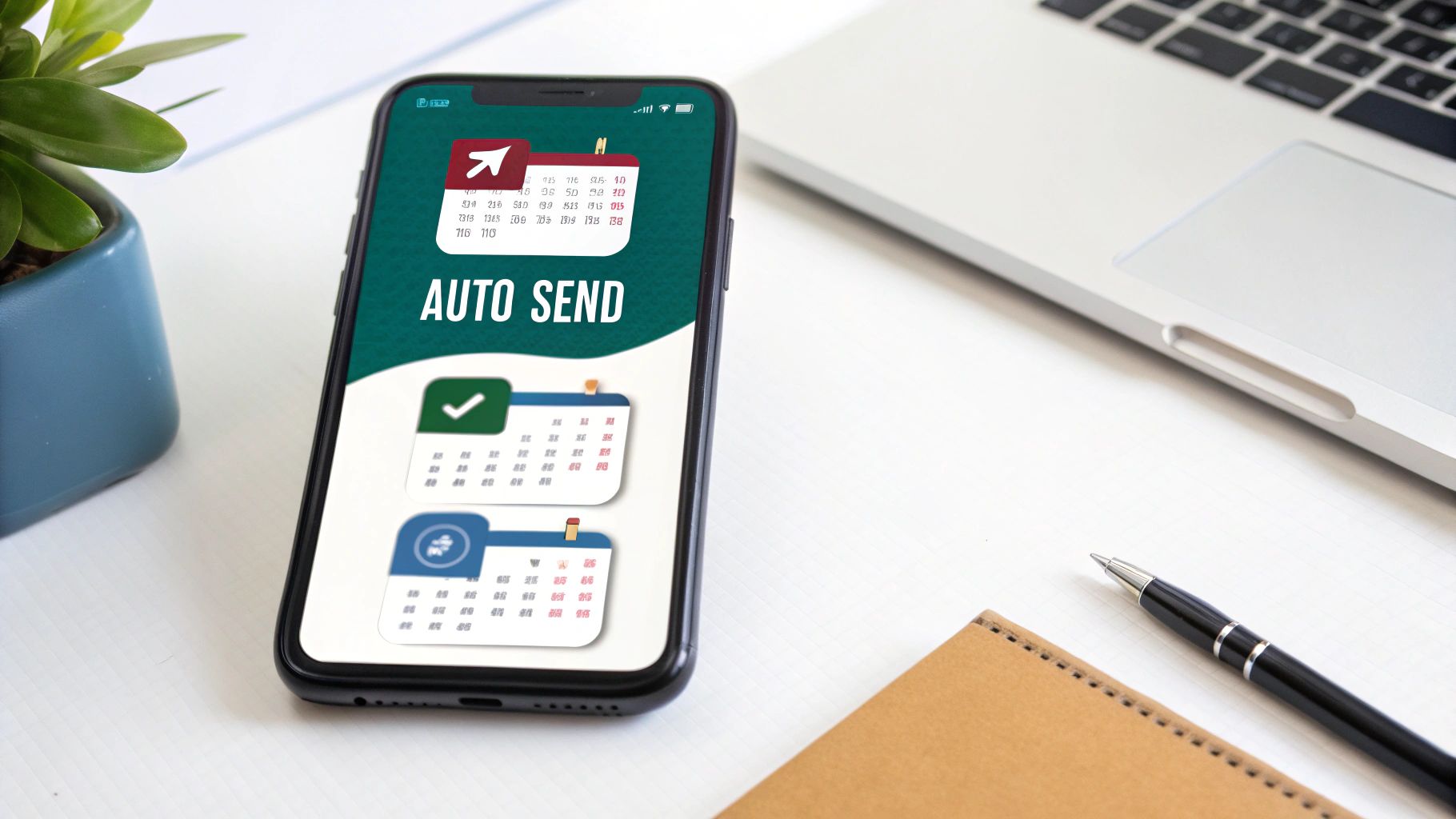Learning how to schedule a message on WhatsApp can completely change how you communicate, but you might be surprised to learn there isn't a single, built-in button for it. Instead, you have a few different paths to take. You can use the WhatsApp Business app for some basic automation, rely on third-party apps for personal use, or tap into powerful API-based platforms like CustomerCloud for serious business scheduling. Each one is built for a different job, from sending a simple reminder to running a full-blown marketing campaign.
Why Scheduling WhatsApp Messages Is a Game Changer

Let’s be clear: scheduling WhatsApp messages is more than just a neat trick. It’s a strategic move that makes you more effective and helps build better connections. We're not just talking about never forgetting a birthday wish again; this is about fundamentally improving how you communicate to get the best results.
Think about the real-world impact. A local salon can automatically send appointment reminders, which dramatically cuts down on no-shows. A team leader managing a global team can schedule project updates to go out at the start of each person's workday, not at 3 AM their time. It’s a small change that makes a huge difference.
Boost Your Productivity and Professionalism
Scheduling lets you get all your communication tasks done in one go, freeing up your time and mental space for more important work. Rather than being glued to your phone and reacting to messages all day, you can proactively set your communications to send at the most impactful moments. This organized method makes you look far more intentional and professional.
Here’s how it plays out in different roles:
- For Freelancers: Imagine your clients in different time zones waking up to your project updates. It instantly creates an impression of diligence and top-tier service.
- For Service Providers: After an appointment, an automated follow-up can ask for feedback or offer a discount on their next visit. It’s a simple way to build loyalty.
- For Community Managers: You can schedule event reminders and announcements in your group chats to keep engagement high without having to be online 24/7.
This one habit—scheduling your messages—ensures your most critical communications land at the perfect time. It turns a simple chat app into a powerful productivity tool. By mastering this, you can check out more details about the iconic WhatsApp logo and its branding.
Keeping Up With Modern Communication
As WhatsApp's popularity has exploded, so has the need for smarter ways to manage our conversations. People exchange roughly 150 billion messages on the platform every single day. That staggering number shows exactly why businesses, in particular, need better workflows.
This massive volume is precisely why scheduling has become so essential for anyone trying to manage a high volume of chats. You can dive deeper into WhatsApp's incredible messaging volume and its implications for businesses to see the full picture. Now, let’s get into the practical steps to make it happen.
Using the WhatsApp Business App for Basic Scheduling

If your business is already on WhatsApp, you have a couple of basic scheduling tools right in your pocket. The standard app doesn't have these, but the free WhatsApp Business app gives you a solid starting point with its "Greeting Messages" and "Away Messages." These are your first, easiest step into automating customer conversations without needing any third-party software.
Now, it's important to understand what these features are and what they aren't. They aren't true schedulers for sending unique messages at a future date. Instead, think of them as smart, automated responders that make sure no customer is ever left on read. They're a simple way to look professional and manage expectations from the very first interaction.
Setting Up Greeting and Away Messages
You can find and set up these tools right inside the app’s “Business tools” section. It’s pretty straightforward, letting you craft messages that send automatically based on a couple of simple triggers.
- Greeting Messages: These go out whenever a customer messages you for the first time or after 14 days of no contact. This is your chance to make a great first impression, welcome a new lead, and maybe share essential info like your business hours or a link to your product catalog.
- Away Messages: These are triggered when someone messages you outside of your defined business hours. It’s a lifesaver for managing expectations and stopping customers from feeling ignored when you’re off the clock.
Let’s say you run a small online store. Your "Away Message" could thank the customer for their query and point them to your FAQ page for quick answers. Or, if you're a consultant, your "Greeting Message" can thank a new prospect for reaching out and let them know you'll reply within a 24-hour window. It’s a small touch that makes a huge difference.
Think of these tools as your digital receptionist. They’re there to handle the front lines, making sure every single customer feels heard, even when you can't get to the phone right away.
While these built-in features are fantastic for basic automation, they have their limits. You can't, for example, write a custom follow-up message today and schedule it to send next Tuesday at 10 AM. That’s a common scenario where businesses realize they need something more powerful. To dig deeper into the branding of this communication giant, you can explore the history behind the well-known WhatsApp icon and its design.
Using Third-Party Apps to Schedule WhatsApp Messages
Since the personal WhatsApp app doesn't have a built-in scheduler, a whole market of third-party tools has popped up to fill that void. These apps are designed to do one thing well: let you write a message now and send it later. It’s a handy solution for personal reminders or sending a one-off message to a small group.
But it's important to know how they work before you dive in. To send a message on your behalf, these apps need deep access to your phone. They often ask for permissions to read your contacts, access notifications, and sometimes even bypass your screen lock. This is a big deal for privacy, so I always recommend thoroughly checking an app's reputation and reading user reviews before giving it that kind of control.
How These Schedulers Typically Work
Most of these tools are pretty straightforward. Once you’ve installed the app and waded through the permission requests, the process usually looks something like this:
- You’ll start by telling the app you want to schedule a WhatsApp message.
- Next, you’ll pick a contact or group directly from your WhatsApp list.
- Then you get to the fun part: writing your message and attaching any files, like photos or PDFs.
- Finally, you set the exact date and time for it to go out and confirm the schedule.
Think about a freelance social media manager who needs to send a "Happy Friday!" check-in to several clients every week. They could set these up on Sunday night and forget about them, knowing the messages will go out on time. Or, a simple personal use case: scheduling a "Happy Birthday!" message for a friend in a different time zone so it arrives first thing in their morning.
One crucial thing to remember: These apps are essentially automating the physical act of sending a message from your device. For them to work without a hitch, your phone usually needs to be on, unlocked, and connected to the internet at the scheduled time. If your phone is off, the message won't send.
The Trade-Off: Convenience vs. Security
So, is it worth it? This image really puts the efficiency gains into perspective.

The numbers are pretty compelling. Scheduled messages have a 99% on-time delivery rate, which blows the 80% from manual sending out of the water. Plus, it cuts the time you spend managing these communications in half.
Here’s the bottom line: you get a massive boost in reliability and you save time. The trade-off is handing over significant permissions to a third-party app. For anyone dealing with sensitive client information or who is simply cautious about privacy, looking into official, API-based solutions is a much safer bet.
Comparing WhatsApp Scheduling Methods
To help you decide which path is right for you, let's break down the different options available.
| Method | Platform | Ease of Use | Best For |
|---|---|---|---|
| WhatsApp Business App | iOS & Android | Very Easy | Small businesses sending greetings or away messages. |
| Third-Party Schedulers | iOS & Android | Easy | Individuals needing personal reminders or one-off scheduled messages. |
| CustomerCloud (API) | Web-based | Moderate | Businesses of all sizes needing reliable, scalable, and secure scheduling. |
Each method has its place. The built-in features of WhatsApp Business are great for basic automation, third-party apps are perfect for casual personal use, and a robust platform like CustomerCloud is the go-to for serious business communication where security and scalability are key.
Advanced Scheduling with the WhatsApp Business API

When you're ready to move beyond basic scheduling, the WhatsApp Business API is your next step. This isn't an app you download; it's a powerful integration that connects WhatsApp to professional business tools like CustomerCloud. This connection opens up a whole new world of sophisticated scheduling that the standard app just can't handle.
The real power here is moving from single, manually scheduled messages to building entire automated conversations. With the API, you can schedule multi-step marketing campaigns, trigger follow-ups based on customer behavior, and design message sequences that nurture a customer from their first inquiry to their final purchase.
A Real-World Scheduling Example
Let's look at how this plays out for a local auto repair shop. By connecting to the API through a platform, their scheduling becomes a complete communication system.
- Instant Confirmation: The second a customer books a service, an automated confirmation message is scheduled and sent. No manual work is needed.
- Helpful Reminders: Then, 24 hours before the appointment, a scheduled message is automatically sent with a friendly reminder and a quick note to clear personal items from the car.
- Follow-Up & Feedback: A day after the service is done, another scheduled message goes out. This one asks for a review and includes a small discount on their next visit, encouraging repeat business.
This entire sequence is automated. It runs in the background, creating a professional and seamless experience for every customer. You’re no longer just sending messages; you’re using WhatsApp as a core tool to run your business more efficiently and keep customers happy.
The impact on a business is huge. The WhatsApp Business API is already a go-to for many small and medium businesses in markets like India, where scheduled messaging is a key driver for customer engagement. With WhatsApp's user base expected to reach 3.14 billion by 2025, this platform gives you a direct line to a massive global audience. You can dig deeper into WhatsApp's global user statistics to see just how big the opportunity is. This is how you truly master scheduling on WhatsApp for real business growth.
Best Practices for Scheduling Messages
Knowing how to schedule a WhatsApp message is one thing. Knowing how to do it well is another entirely. If you’re not careful, automation can feel cold and robotic, which is the last thing you want on a personal platform like WhatsApp. The real goal is to make your scheduled messages feel timely and personal, not like they came off a conveyor belt.
It all starts with something simple: respecting people's time. Imagine getting a promotional message pinging on your phone at 2 AM. It's an instant way to annoy, and possibly lose, a customer. A good rule of thumb I always follow is to schedule business communications to land between 8 AM and 9 PM in the recipient’s local time zone. It’s a small detail that shows you’re being considerate, and it makes a huge difference in how your message is received.
Crafting Messages That Don't Sound Like a Robot Sent Them
Next up is the content of the message itself. A generic, one-size-fits-all blast is a dead giveaway that it's automated. The trick is to weave in personal details wherever you can.
- Use their name. It sounds obvious, but you'd be surprised how many businesses skip this. A simple "Hi David," is far more effective than no greeting at all.
- Bring up past interactions. If you can, reference a previous purchase or a specific conversation. Something like, "Just following up on our chat about the new inventory…" shows you remember them.
- Keep your tone conversational. Write like you speak. WhatsApp is informal, so ditch the corporate jargon and use a friendly, approachable voice.
A bit of personalization goes a long way. In fact, personalized messages can boost engagement by over 40%. It’s a small effort that shows the person on the other end that you see them as an individual, not just another contact in a list.
Knowing When to Automate and When to Go Live
Finally, it’s critical to be strategic. Not every message should be scheduled. Automation is a lifesaver for appointment reminders, routine check-ins, or sending information to someone in a different time zone. But for anything urgent, sensitive, or requiring a nuanced back-and-forth, real-time messaging is always the better choice.
Don't let scheduling replace genuine human connection where it counts. When you combine the convenience of scheduling with a thoughtful, personal touch, you create a powerful communication system. As you can see from this scheduling interface example, modern tools give you the flexibility to set up these thoughtful messages well in advance.
Common Questions About Scheduling WhatsApp Messages
Even after you've picked a method, a few questions probably come to mind. It's one thing to know how to schedule a message on WhatsApp, but it's another to feel confident about the safety, privacy, and little details of how it all works. Let's tackle some of the most common concerns we hear from people just getting started.
The biggest question is almost always about security. Is it actually safe to use those third-party apps for scheduling? Honestly, it's a mixed bag. Many of these tools need some pretty invasive permissions to work—things like asking you to disable your phone’s screen lock or letting them read your notifications. That can open the door to security risks.
I’ll be blunt: be extremely careful here. While a third-party app might be fine for a casual "Happy Birthday" reminder, I would never trust one that asks me to turn off my phone's security features, especially for sending sensitive business or personal info. For any professional use, sticking with an official API-based solution is hands-down the safest route.
Practical "What If" Scenarios
Now, let's get into the nitty-gritty details that pop up when you start using these tools.
A question I get all the time is about group chats. The good news is, yes, you can schedule messages in group chats. Nearly every third-party app and all API platforms like CustomerCloud let you pick a group as the recipient, just like you would an individual. It's fantastic for sending out weekly team updates or reminders for a family event.
People also wonder if the person on the other end can tell the message was automated. The answer is no, there is absolutely no indicator that a message was scheduled. It lands in the chat looking exactly like a message you typed out and sent manually. This is great for keeping your communication feeling personal and natural.
Device Status and Managing Your Messages
What happens if your phone is turned off when a message is supposed to send? This is where the method you choose makes a huge difference.
- Third-Party Apps: For most of these schedulers, your phone needs to be on, unlocked, and connected to the internet. If your phone is off, the message simply won't send.
- API Platforms (like CustomerCloud): Because these tools work through the cloud, they don't rely on your phone at all. Your message gets delivered right on schedule, even if your phone is out of battery, sitting in a drawer, or has no signal.
And finally, what if you spot a typo or just change your mind? You can almost always edit or delete a scheduled message before it goes out. Just head back into the scheduling app or platform, find the pending message, and you’ll see options to tweak the text, push back the time, or cancel it completely. You have full control right up until the moment it sends.
Ready to leave the limitations and security worries of basic schedulers behind? With CustomerCloud, you can schedule messages securely and reliably using the official WhatsApp Business API. You can manage entire campaigns, automate your follow-ups, and be certain your messages are delivered on time, every time—without giving your phone's status a second thought. Discover a smarter way to schedule with CustomerCloud.